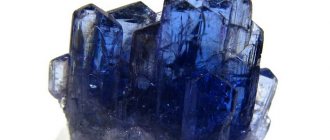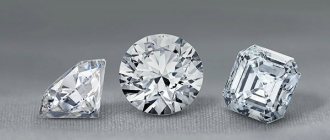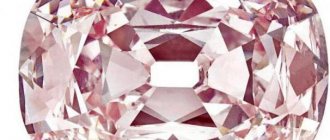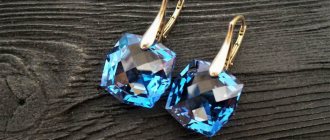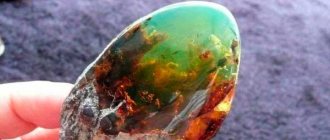Cat eye effect
The cat's eye effect appears in stones that are aggregates of parallel fused needle-like and fibrous individuals or in stones that contain thin, parallel-oriented hollow channels. The effect occurs as a result of the reflection of light on parallel accretions or on parallel channels when the stone is turned and a narrow light strip runs across it, which evokes the glowing slit-like pupil of a cat. The greatest effect is seen in polished cabochon-shaped stones when the flat base of the cabochon is parallel to the fibrous structure of the stone. The most valuable stone with the cat's eye effect is chrysoberyl cat's eye, also called simply cat's eye. Also known are quartz cat's eye, hawk's eye and tiger's eye. Apart from the chrysoberyl cat's eye, all others need a more precise mineralogical definition, such as quartz eye.
General information
Ursa Major Bucket. Try to find 2 popular galaxies among astronomy lovers in this image.
The word "asterism" comes from the Greek word ἀστήρ, which means star. Humanity has always admired asterisms. We find mentions of these beautiful celestial figures in all cultures of antiquity. The most popular asterism, which probably almost every person on Earth knows about, is the Big Dipper. The Big Dipper is part of the constellation Ursa Major, which depicts the torso and tail of an animal.
Back in the 19th century, people considered asterism to be a synonym for such an astronomical term as “constellation.” However, in 1922 these concepts were separated. Since then, the word “constellation” has been understood as a certain area of the sky, and the word “asterism” continues to be understood as a certain group of stars.
For modern scientific astronomy, asterisms are of no particular value. These celestial objects are more valuable for culture and navigation. In most asterisms, the stars are located at a considerable distance from each other, that is, they cannot be considered true star clusters. The only exception here could be the Pleiades asterism and similar asterisms, which are actually star clusters.
Irisation
The iridescence effect is an iridescent play of colors that appears only in certain gemstones.
Iridescence is the effect of natural opal stone
The iridescence of a stone occurs as a result of the decomposition of white light into spectral colors and, at the same time, is refracted at small breaks or cracks in the stone. The iridescence of rock crystal increases its value, so sometimes the iridescence is created artificially.
Artificially creating an effect
A similar optical effect can be created by artificially synthesized stones. For example, during the growth of artificial corundum crystals, titanium dioxide is added to liquid aluminum oxide. As a result, thin rutile fibers are formed in leucosapphire. Now, after crystallization of the substance, for the appearance of a six-rayed star, it is enough to polish the surface. The popularity of the star effect leads to an increase in the number of fakes. Sapphires and rubies are mainly synthesized.
Asterism
The effect of asterism appears on the surface of the stone in the form of light figures that look like light stripes intersecting at one point and are somewhat similar to star rays. There can be different numbers of these rays and they can intersect at different angles depending on the symmetry of the crystals. This effect is similar to the cat's eye effect and differs in that reflective inclusions such as fibers, needles or tubules have different orientations in different areas. Such star stones are also sometimes called asteria. The six-pointed stars on ruby and sapphire cabochons look very impressive. Four-rayed stars and very rarely twelve-rayed stars can also be found. Underdeveloped stars can also be found, for example in rose quartz which is polished in the shape of a ball, and such stars have the appearance of circular scales with division lines or brightly light points. They appear if the rays pass in circles over the entire surface of the ball, and the arrangement of needle-shaped inclusions turns out to be partially disrupted. Constellation asterisms are specially created in synthetic stones for jewelry.
Conditions for appearance
Many precious stones, after being processed, can boast of similar beauty. It appears when the basic chemical composition of the mineral contains fine fibrous inclusions. Considering that these particles (for example, magnetite or hematite) were formed at different times, they have different geometries and are displaced in the space of the crystal.
The second condition for the emergence of a star is the asymmetry of these fibrous inclusions. This data manifests itself differently in different gems. It is difficult to see a clearly defined star with six rays on the surface of an emerald. Basically, wide blurred rays converge into one point. At that time, sapphire often has clearly defined silhouettes of the design.
Varieties
There are twelve-rayed, and four-, or two-rayed stars. For example:
- Natural ruby, some types of sapphire and South Asian corundum are capable of forming 12 pointed stars;
- Most sapphires, quartz, spinel, emerald are six-pointed;
- Moonstones, diopside, andesine, almandine garnet - four-rayed;
- Tsimofan - two rays.
Stars appear when processing quartz, emerald and spinel.
12-pointed star on corundum, 6-pointed on sapphire, 2-pointed on cymophane.
Features of the structure of the drawing
The thin, slightly refracted rays of the 12-pointed corundum star are divided into pairs. Although similar to a hand-made drawing, they still surpass it in originality. After all, the artist in this case is nature.
The four terminal diopside stars have slightly offset perpendicular rays, and the glare resembles the night reflection of the Moon on the surface of the water.
Diopside
Optical properties of precious and semi-precious natural stones
In this article I want to talk in more detail about the optical properties of precious and semi-precious stones. Without light, we would not be able to appreciate the bright green of emeralds, the rich red of rubies, the noble blue of sapphires , the sunny yellow of heliodor , or the delicate, pinkish-orange, like the rising sun, padparadscha sapphire . It is the energy of light that brings the colors of gemstones to life.
Color is the most obvious optical property, but exactly how light interacts with a stone's surface depends on its other optical properties, all of which together make each gemstone unique. The way a gemstone reflects and transmits light not only helps a gemologist identify it, but also determines its quality and beauty.
Even if a stone appears metallic, glassy, or dull, the light reflected from its surface gives it shine. The nature of the shine and its brightness depend on the quality of the surface, the degree of its polishing and the refractive index. The more light is reflected both from the surface of the stone and from the inside, not only from the top, but also from the bottom, the brighter the stone sparkles.
The amount of light that can pass through the stone determines whether it will be transparent, translucent (translucent: enough light to see an image through the stone, but not enough to read handwriting), or opaque.
Light dispersion.
The spectral colors of sunlight (white) light are the same colors that make up a rainbow. Each color corresponds to a wave of a certain length and with a certain amount of energy, and a rainbow occurs when light hits raindrops and each wave is refracted to a different degree (the ability of light to refract is characterized by its refractive index). This phenomenon is called light dispersion. Gemstones such as diamonds, which are highly dispersive, sparkle in a rainbow of colors when the stone or light source changes its position.
The colors of the rainbow are the colors of the visible spectrum of sunlight (white) light. Other components of the visible spectrum - x-rays, ultraviolet and infrared rays - interact with the surface of the crystal, change its color or cause optical effects such as fluorescence or phosphorescence.
Refractive index, birefringence and refractometer.
Light falling on the surface of a gemstone and encountering a denser medium is diverted from its original path in the air. Non-crystalline materials and materials having a cubic crystal lattice reflect light equally in all directions and are called unirefringent.
Precious stones belonging to other systems are called birefringent. When hitting such a stone, a ray of light is divided into two rays, each of which is reflected to a different extent. If this difference is large, as in calcite, birefringence (birefringence) can be observed through the stone as a double image.
In sphalerite, a double image of the lower part of the faceted stone (pavilion facets) can be seen if you look at it through the upper part of the crystal (crown facets).
The relationship between the angle of incidence of the ray and the angle of reflection is expressed by a mathematical formula from which the refractive index of a gemstone can be calculated.
The refractive index of most gemstones can be accurately measured using a refractometer or Brewster protractor; they are used in identifying stones. Unirefringent stones have one refractive index, while birefringent stones have several indexes. The difference between the maximum and minimum values characterizes the degree of birefringence.
Reflection effects.
Interference - iridescence and play of colors.
The rainbow effect (multi-color), which is observed in cracks along cleavage planes, and the iridescence of labradorite and hematite are a consequence of the interference of light reflected from thin layers (films) inside the stone. In moonstone, this effect is known as opalescence (or shillerization), and the iridescent colors on the surface of pearls are called pearlescent luster.
When light is reflected, interference of different wavelengths occurs. When waves of the same length interfere, the color corresponding to that wavelength is enhanced; in other cases, the waves “cancel” one another, and the color becomes invisible.
In opal, interference of light waves occurs when light passes between the regularly spaced spheres that form its structure. The size of the spheres and the distance between them, as well as the distance from which the opal is viewed, affect the degree of dispersion and, as a result, the play of color.
When the stone is turned, the small spheres reveal only blue and purple colors, while the larger, regularly spaced spheres show the full spectrum of the rainbow.
Cat's eye effect, crystal asterism and silk.
Other effects of internal refraction of light include shimmering colors, crystal asterism, and “silk,” which are caused by inclusions found in natural gemstones.
The shimmering of colors is the so-called "cat's eye" effect found in some cabochon-cut gemstones, which is best seen in bright light. Light is reflected from parallel elongated or needle-shaped crystals of inclusions of minerals such as rutile or tourmaline, fibers or elongated cavities.
Examples of gemstones that exhibit this effect are quartz, beryl, ruby, sapphire and tourmaline.
Asterism is characteristic of gemstones that have two or more parallel inclusions forming stars.
Stars can have four, six, twelve or even twenty-four rays. Star sapphires and rubies typically have six arms running parallel to the crystallographic axis. Other stones that can display stars when cut cabochon include quartz, garnet, and spinel.
If inclusions or cavities are present in insufficient quantities to form a star, they may be visible as microscopic needle-shaped inclusions when light is reflected from small clusters of parallel inclusions, and appear as silk to the eye. A similar phenomenon can often be observed in sapphires.
Differences between an asterism and a constellation
The fact is that all 88 constellations in the sky have well-defined boundaries and occupy a certain area. Of course, the brightest stars in them may form some kind of figures - asterisms, or they may not. Some constellations have only a couple of bright stars, and some have nothing at all for the eye to catch on.
For example, in the constellation Pegasus, bright stars form a clearly visible square. This is an asterism that is called the Great Square of Pegasus. And in the neighboring constellation Andromeda, bright stars stand in an uneven row and there is no noticeable asterism there. Although in the left corner of the square is a star from Andromeda.
An asterism can be some small part of a constellation. For example, the sword of Orion, or the belt of Orion are two well-known asterisms that are located in the same constellation.
In addition, asterisms can form stars that belong to completely different constellations. For example, Vega (alpha Lyrae), Deneb (alpha Cygnus), and Altair (alpha Aquila) are the brightest stars in the summer night sky. They form the Great Summer Triangle asterism.
But there are small constellations where there are few stars, they are quite bright and they all form some kind of figure. For example, most of the stars in the constellation Delphinus actually form the shape of a dolphin. But this is not an asterism, because this is practically the entire constellation. Or the constellation of the Northern Crown - here the concepts of asterism and constellation also merge, because the asterism includes all the bright stars of the constellation.
But the Ursa Major bucket can be called an asterism, because the constellation itself is much larger, and not all of its stars are included in the shape of the bucket - there are others that are located to the side. This figure is simply noticeable, and it forms an asterism. It also has other names, for example, Wheelbarrow.
The well-known asterism Big Dipper in Ursa Major.
Even clusters can be classified as asterisms - for example, the brightest stars of the Pleiades cluster also form a shape similar to a ladle.
The very concept of asterism has nothing to do with science - constellations are taken into account there. And all these figures simply make it easier to navigate the starry sky. And this is a tribute to the past, when people in the sky gave suitable names to such noticeable groups of stars, and there was no strict distinction between constellations yet.
Archetype[edit]
A typical asterium is a star sapphire, usually corundum with almost uniform impurities, bluish-gray, milky or opalescent, which when illuminated has a star of six rays. In the red specimen, the star reflection is less common; The star ruby, sometimes found along with the star sapphire in Sri Lanka, is one of the most valuable "fancy stones". Other examples are star topaz and some prized iridescent (cat's eye) chrysoberyl stones, particularly those from the Cymophane (yellow) variety.

